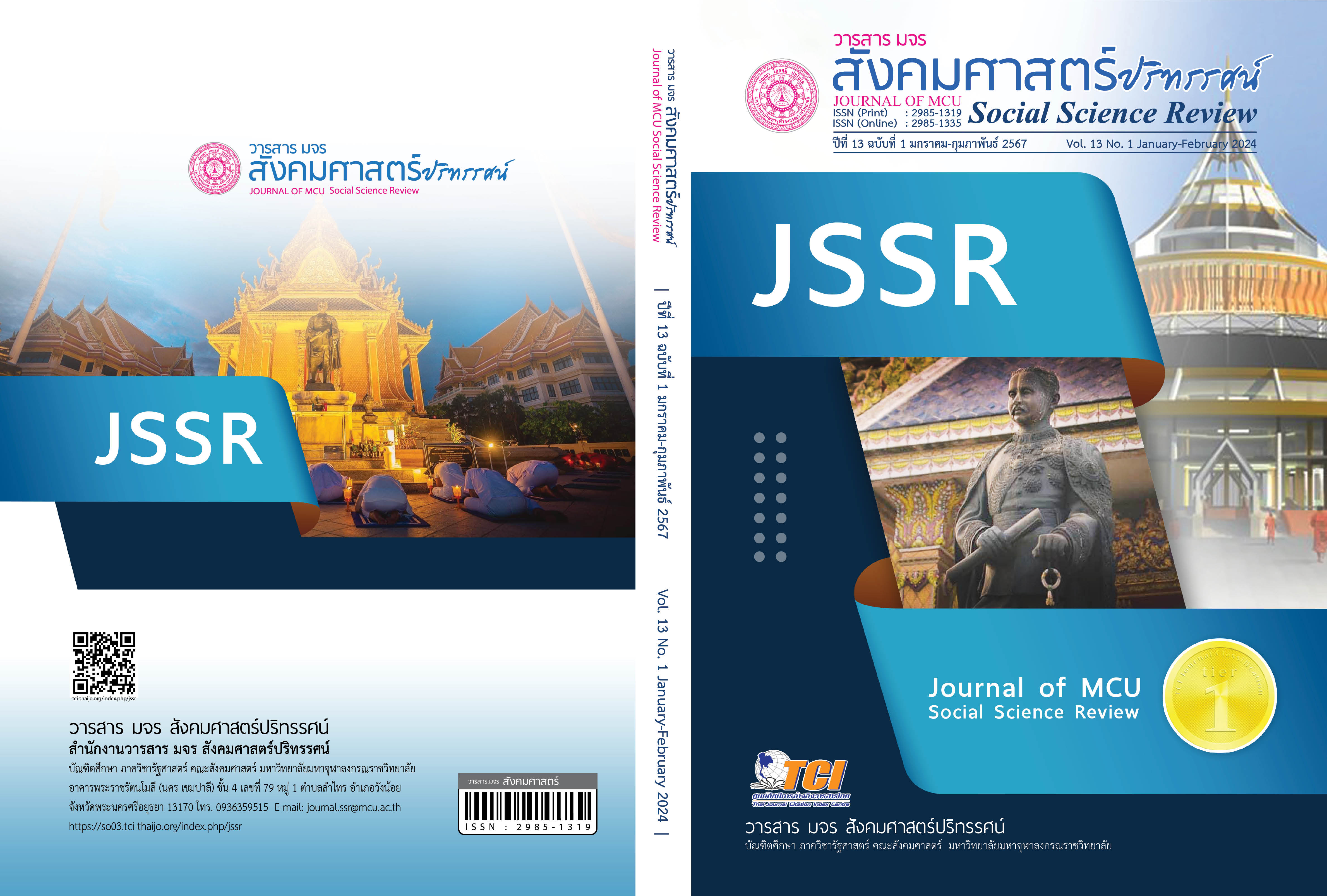WISDOM AND CULTURAL CAPITALS OF COMMUNITY FLEA MARKET TO PROMOTE TOURISM IN CHAINAT PROVINCE
Keywords:
Collective Wisdom and Cultural Assets, Community Market, Tourism, Chai Nat ProvinceAbstract
This research article aims to analyze the wisdom and cultural capitals of the community flea market to promote tourism in Chainat Province and assess the potential of the community flea market in promoting tourism in Chainat Province. It is qualitative research. The key informant group was 10 people who were community leaders and people in the community involved in the development of the community flea market. The sample group was specifically specified. The research tool was an in-depth interview form.
The results showed that the wisdom and cultural capitals of the community flea market were diverse and distinctive, both tangible and intangible in 6 areas: 1) local food and seasonal food, focusing on the use of ingredients within the community, traditional cooking methods and inexpensiveness; 2) local products that reflect the creations from local materials in the central region; 3) local history as the route of King Chulalongkorn’s private travel; 4) beliefs and rituals influenced by temples, which are the location of the community flea market; 5) in terms of the form of shops, found 3 types, namely permanent shops, temporary shops. and semi-permanent shops; 6) local architecture which is ancient and beautiful. The potential of the community flea market to promote tourism was found that it has the potential to be developed into a tourist attraction that reflects its identity based on the community wisdom and culture that will lead to creating a tourism experience for tourists to come back to visit again.
References
จริยา สุพรรณ และคณะ. (2564). การจัดการความรู้เพื่อพัฒนาเรื่องเล่าและกิจกรรมการท่องเที่ยวจังหวัดชัยนาท จังหวัดสิงห์บุรี และจังหวัดลพบุรี (รายงานการวิจัย). กรุงเทพฯ: หน่วยบริหารและจัดการทุนด้านการเพิ่มความสามารถในการแข่งขันของประเทศ.
ญาณภา บุญประกอบ และคณะ. (2560). อาหารพื้นถิ่นกับกลไกในการส่งเสริมการท่องเที่ยวเชิงสร้างสรรค์: กรณีศึกษากลุ่มชาติพันธุ์ลาวครั่ง จังหวัดชัยนาท. วารสารวิทยาลัยดุสิตธานี, 11(ฉบับพิเศษ), 93-108.
เทิดชาย ช่วยบำรุง. (2554). ภูมิปัญญาในการพัฒนาท้องถิ่นเชิงสร้างสรรค์. กรุงเทพฯ: สถาบันพระปกเกล้า.
ธานี กุลแพทย์. (2539). บทบาทของตลาดนัดจตุจักรที่มีต่อชุมชนกรุงเทพฯ และปริมณฑล พ.ศ. 2525-2537 (สารนิพนธ์ศิลปศาสตร์มหาบัณฑิต สาขาวิชาประวัติศาสตร์). กรุงเทพฯ: มหาวิทยาลัยธรรมศาสตร์.
นุชนารถ รัตนสุวงศ์ชัย และคณะ. (2564). โลจิสติกส์การท่องเที่ยวเชิงสร้างสรรค์ในจังหวัดชัยนาท จังหวัดสิงห์บุรี และจังหวัดลพบุรี (รายงานการวิจัย). กรุงเทพฯ: หน่วยบริหารและจัดการทุนด้านการเพิ่มความสามารถในการแข่งขันของประเทศ.
ประทีป พืชทองหลาง และญาตาวีมินทร์ พืชทองหลาง. (2559). ตลาดเก่า : ทุนวัฒนธรรมเพื่อการท่องเที่ยวในเขตภาคเหนือตอนบน. วารสารสังคมศาสตร์และมนุษยศาสตร์, 42(2), 100-124.
มิ่งสรรพ์ ขาวสอาด. (2555). การท่องเที่ยวไทยจากนโยบายสู่รากหญ้า (พิมพ์ครั้งที่ 2). เชียงใหม่: สถาบันศึกษานโยบายสาธารณะ.
รัฐวิชญ์ ชัยศิริพานิช. (2562). การศึกษา 5 เสน่ห์วิถีชุมชนที่มีผลต่อความจงรักภักดีของนักท่องเที่ยว ตลาดหัวปลี ศูนย์โอทอป (OTOP) คอมแพลกซ์ ตำบลพุแค อำเภอเฉลิมพระเกียรติ จังหวัดสระบุรี (วิทยานิพนธ์บริหารธุรกิจมหาบัณฑิต สาขาบริหารธุรกิจ). กรุงเทพฯ: มหาวิทยาลัยศิลปากร.
รัตนพล ชื่นค้า และจริยา สุพรรณ. (2562). ภูมิปัญญาท้องถิ่นจังหวัดชัยนาทกับการส่งเสริมการท่องเที่ยวอย่างยั่งยืนและสร้างคุณค่าเพิ่มให้แก่ผลิตภัณฑ์ชุมชน (รายงานการวิจัย). กรุงเทพฯ: มหาวิทยาลัยเกษตรศาสตร์.
วิชชุดา เขียวเกตุ. (2559). การจัดการตนเองของตลาดชุมชน กรณีศึกษาตลาดริมน้ำคลองแดนอำเภอระโนด จังหวัดสงขลา (วิทยานิพนธ์พัฒนาชุมชนมหาบัณฑิต สาขาวิชาการพัฒนาชุมชน). กรุงเทพฯ: มหาวิทยาลัยธรรมศาสตร์.
สัจจา ไกรศรรัตน์ และวรรักษ์ สุเฌอ. (2560). กระบวนการสร้างตราสินค้าให้กับตลาดชุมชนโบราณลุ่มน้ำสุพรรณบุรีในฐานะของแหล่งท่องเที่ยว. วารสารมนุษยสังคมปริทัศน์, 19(2), 35-48.
สำนักพัฒนาชุมชนอำเภอวัดสิงห์. (2564). เรียนรู้ สัมผัสวิถี ของดีชุมชน. สิงห์บุรี: สำนักงานพัฒนาชุมชนอำเภอวัดสิงห์.
สุชานาถ พัฒนวงศ์งาม. (2560). ตลาดนัดชุมชนเป็นเศรษฐกิจฐานรากของจุดเริ่มต้นของกระบวนการโลจิสติกส์ : กรณีศึกษาตลาดนัดชุมชนบริเวณสนามกีฬาเทศบาลเมืองฉะเชิงเทรา. วารสารวิทยาการจัดการสมัยใหม่, 10(2), 197-212.
เสรี พงศ์พิศ. (2553). ร้อยคำที่ควรรู้ฉบับปรับปรุงใหม่. กรุงเทพฯ: สำนักพิมพ์พลังปัญญา.
Komppula, R. (2011). Customer value-based experience design in tourism University of Eastern Finland. Retrieved November 24, 2020, from https://matkailu.luc.filoader.aspx?id=e6f8bae0-ff62-4425-8a85
Pine, B. J. II. & Gilmore, J. H. (1998). Welcome to the Experience Economy. Harvard Business Review, 76(4), 96-105.
Sheth, J. N., et al. (1991). Why We Buy What We Buy: A Theory of Consumption Values. Journal of Business Research, 22(2),159-170.
Downloads
Published
How to Cite
Issue
Section
License
Copyright (c) 2024 Journal of MCU Social Science Review

This work is licensed under a Creative Commons Attribution-NonCommercial-NoDerivatives 4.0 International License.
In order to conform the copyright law, all article authors must sign the consignment agreement to transfer the copyright to the Journal including the finally revised original articles. Besides, the article authors must declare that the articles will be printed in only the Journal of MCU Journal of Social Sciences. If there are pictures, tables or contents that were printed before, the article authors must receive permission from the authors in writing and show the evidence to the editor before the article is printed. If it does not conform to the set criteria, the editor will remove the article from the Journal without any exceptions.





